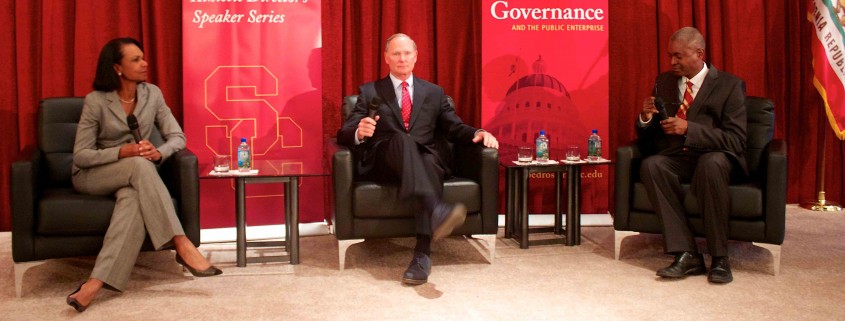Condoleezza Rice visits campus, speaks on governance in collegiate sports
Former Secretary of State Condoleezza Rice spoke with USC Athletic Director Pat Haden on the state of governance in college sports at Town & Gown on Monday evening. Price Professor and Judith and John Bedrosian Chair in Governance moderated the conversation, which was hosted by the Judith and John Bedrosian Center on Governance and Public Enterprise and the USC Department of Intercollegiate Athletics.
The event was attended by invitation only and the guests included leadership from the Bedrosian Center, Price School of Public Policy and USC Athletics, along with student athletes, Price student ambassadors and Price faculty affiliated with the Bedrosian Center.
Rice, who served as Stanford Provost between 1993-1999 overseeing the athletic department, is a lifelong athlete and is currently a member of the college football playoff committee with Pat Haden.
Rice and Haden discussed from their personal experience managing collegiate athletic departments, what steps need to be taken to better the environment for student athletes.
Haden discussed the need to focus on the academic side of the student athlete experience as much as the athletic side. Haden stated that this is something he has strived for during his nearly five years as athletic director and achieved given that, according to him, the fall 2014 semester was the best academic semester in 126 years of USC athletics.
“We’re really proud of the academic tone [the USC athletic department has set],” Haden said. “We’re trying to be as good as the rest of the university.”
Rice also emphasized the importance of a cohesive relationship between academics and athletics, stating that during her time as Stanford Provost, the issue was one she took very seriously.
“I remember saying to the athletic director…if ever you come in here and tell me that a coach has complained about academics, complained about admissions, they’re gone, no questions asked,” Rice said. “I don’t want athletics and Stanford academics to start to pull apart.”
Additionally, Haden, who has a history in the private sector, described collegiate sports as a poor business model.
“In 19 of our 21 sports we lose about $2 million a year,” Haden said. “Total revenue for the 19 sports last year was $175,000.”
Rice echoed Haden’s sentiments, stating that universities are not in the business of college sports like sports companies such as ESPN are that make considerable profits off of coverage of student athletes.
“It’s funny when I hear people say ‘well, college athletics is just a business,’” Rice said. “This is not a model that you would follow if you were going to form a business.”
Rice and Haden also discussed ways to improve the lives of student athletes in their unique position of juggling a full-time sport with a full-time academic course load.
Rice discussed the difficulties of athletes to fit work into their schedules and how this puts them at a disadvantage financially with the full cost of attendance, factoring in everyday living expenses on top of tuition.
“I have watched athletes struggle with the fact that because of their schedules with both academics and athletics, it’s hard to work, hard to pick up a little extra money … to cover basic everyday expenses and given that athletes come from variable economic backgrounds, perhaps there is something to be said for full cost of attendance,” Rice said. “I’ve always felt that four-year scholarship is a must. I don’t understand the argument that brings somebody in and then you don’t commit to them for the full time in scholarship.”
Haden also spoke on the topic of improving the living conditions for student athletes. According to Haden, the student athletes at USC are only provided meals during their respective sport’s season, and even during their seasons, are only provided with one meal a day.
“We had a football player about two years ago who came to me … and hadn’t been able to eat for three days. He ran out of money,” Haden said. “I think that’s … wrong. We need to be doing more for student athletes and we are.”
Haden said that the NCAA has allowed universities to now feed their kids more and do more to assist in the full cost of attendance. According to Haden, over $1 million is being spent on additional food for USC student athletes.
Despite these changes though Haden says that he still feels more could be done to improve the experience of student athletes at the university.
“Our kids just need more time off,” Haden said. “They need to get away from the sport some and … we want our kids to have a real college experience, not just athletic experience.”
Rice also emphasized the lack of time that student athletes have in their schedules due to the academic and athletic demands they face, and said that this has led to a decreasing number of two sport athletes at universities.
Rice also touched on the issue of student athlete unionization, stating that she disagrees with the divide it would create between students and athletes. She even said that she would fully support the Stanford University President in pulling Stanford athletics out of Division One, if the decision was ever made to unionize.
“I don’t think student athletes are or should be considered employees,” Rice said. “That, to me, is a complete reversal of the entire concept of college athletics.
According to Rice, officials can fix major problems involving student athletes without unionization, but the key is to be proactive.
“I think that getting ahead of some of those issues would probably have led people to not think about unionization,” Rice said. “You shouldn’t have to unionize to think about the full cost of attendance. You shouldn’t have to unionize to think about four-year scholarship. You shouldn’t have to unionize to have concussion protocol in college athletics that is at least as demanding as the concussion protocol in the NFL.”

